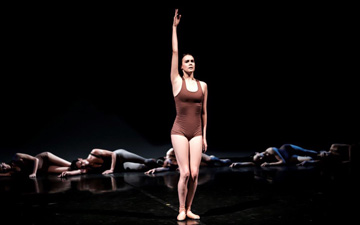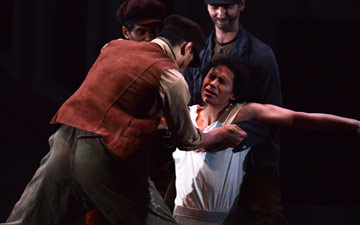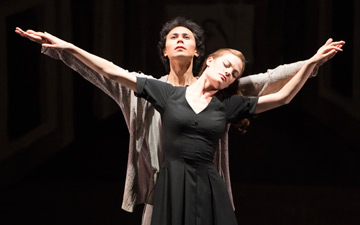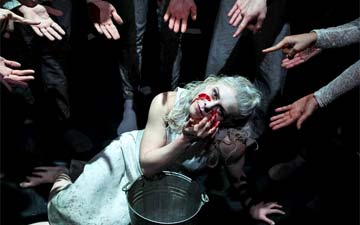
© Kathryn Wirsing. (Click image for larger version)
Gemma Bond
Harvest: Being, Manner, Depuis le Jour, Then and Again
New York, Danspace Project
★★★✰✰
6 February 2016
gemmabonddance.com
www.danspaceproject.org
Up and Coming
Gemma Bond, a senior corps de ballet dancer with American Ballet Theatre, is a precise, neat dancer, trained at the Royal Ballet, with a talent for acting; she’s appropriately light-footed as Amour in Don Q, and an extremely touching Vera in Frederick Ashton’s A Month in the Country. Bond has spoken of her contentment with dancing in the corps; she saves her creative ambitions for choreography. This weekend, she presented an evening of works, “Harvest,” at Danspace Project, downtown. The dancers were her colleagues from ABT.
I’ve seen pieces of hers here and there, at ABT’s “Innovation Initiative,” a program aimed at encouraging creation by company members, and at New York Theatre Ballet, a chamber company known for giving opportunities to women choreographers. (All too rare in ballet, as we know.) More recently, she was given a fellowship from the New York Choreographic Institute, an important stepping stone. She’s clearly in it for the long haul. With grit and determination – and little of the fuss that surrounds promising young men in the field – she’s teaching herself to become a choreographer.
The program at Danspace consisted of four works. Well, three, really, plus a brief introductory solo for the New York Theatre Ballet dancer Steven Melendez, dancing with his shadow. The setting, the church of St. Mark’s in the Bowery, with its stained-glass windows, suited the simplicity and elegance of the evening, a throwback to an earlier time. The costumes, simple tunics and skirts in neutral colors for the women, white trousers for the men, flattered the dancers’ physiques and showed off their refinement. The women wore their hair in low buns. Everything was extraordinarily tasteful.
This goes for the choreography as well. Bond is musical, and has a way of showing off the women’s grace and femininity with soft, fluid movements, bends of the torso, rounded, classically-inspired arms, generous épaulement. The first piece, “Manner,” set to Liszt piano pieces, is built from these elements; the two women (Katie Williams and Lauren Post) are like nymphs descended from a fresco at Pompeii, or followers of Isadora Duncan. At the start, they kneel together, swaying as if moved by a soft breeze. Later, two men (Thomas Forster and José Sebastian) join them, assisting them in low, gliding lifts. The technique is clean, pristine.
“Depuis Le Jour,” set to a recording of an aria by Gustave Charpentier (sung by a breathy soprano) had more drama. Again it began with the two dancers (Devon Teuscher and Calvin Royal III) sitting on the floor. They churned and twisted, then rose to perform a somewhat tormented pas de deux. Teuscher wore soft shoes and a long skirt, which enlarged her movements. It’s nice to see a young choreographer willing to tap into emotion; so many of the ballets today are so technical, so glibly formal. Bond clearly wants to delve into something deeper, even if, at this point, the emotion still feels somewhat unspecific.
“Then and After,” the longest piece on the program, had a central figure, a woman (Stephanie Williams) struggling to find her place in a group. She often sat on the sidelines, watching the others with a hurt expression. The partnering here was a bit more daring; legs hooked over arms, bigger lifts, torsos folding over each other. The men had more to do, bigger jumps, lots of turns. The dancers – and how nice it is to see such dancers up close – performed with real integrity and grace, their expressions open, their eyes alive. Bond has clearly coached them well.
Her strength, for now, lies in a kind of old-fashioned insistence on beauty and her ability to coax sensitive, generous performances out of her dancers. Her simple, uncluttered approach is pleasing to the eye. At the same time, she plays things a little safe; there’s not much tension or risk in her approach. But still, a focus on beauty and musicality is not a bad place to begin. The question is, where she’ll go from here.

















You must be logged in to post a comment.